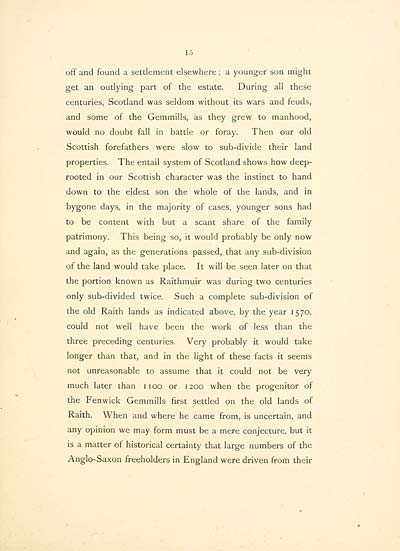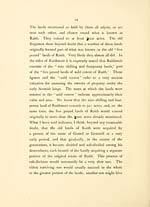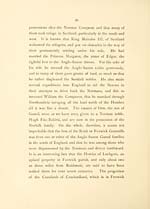Download files
Complete book:
Individual page:
Thumbnail gallery: Grid view | List view

15
off and found a settlement elsewhere ; a younger son might
get an outlying part of the estate. During all these
centuries, Scotland was seldom without its wars and feuds,
and some of the Gemmills, as they grew to manhood,
would no doubt fall in battle or foray. Then our old
Scottish forefathers were slow to sub-divide their land
properties. The entail system of Scotland shows how deep-
rooted in our Scottish character was the instinct to hand
down to the eldest son the whole of the lands, and in
bygone days, in the majority of cases, younger sons had
to be content with but a scant share of the family
patrimony. This being so, it would probably be only now
and again, as the generations passed, that any sub-division
of the land would take place. It will be seen later on that
the portion known as Raithmuir was during two centuries
only sub-divided twice. Such a complete sub-division of
the old Raith lands as indicated above, by the year 1570,
could not well have been the work of less than the
three preceding centuries. Very probably it would take
longer than that, and in the light of these facts it seems
not unreasonable to assume that it could not be very
much later than 1 100 or 1200 when the progenitor of
the Fenwick Gemmills first settled on the old lands of
Raith. When and where he came from, is uncertain, and
any opinion we may form must be a mere conjecture, but it
is a matter of historical certainty that large numbers of the
Anglo-Saxon freeholders in England were driven from their
off and found a settlement elsewhere ; a younger son might
get an outlying part of the estate. During all these
centuries, Scotland was seldom without its wars and feuds,
and some of the Gemmills, as they grew to manhood,
would no doubt fall in battle or foray. Then our old
Scottish forefathers were slow to sub-divide their land
properties. The entail system of Scotland shows how deep-
rooted in our Scottish character was the instinct to hand
down to the eldest son the whole of the lands, and in
bygone days, in the majority of cases, younger sons had
to be content with but a scant share of the family
patrimony. This being so, it would probably be only now
and again, as the generations passed, that any sub-division
of the land would take place. It will be seen later on that
the portion known as Raithmuir was during two centuries
only sub-divided twice. Such a complete sub-division of
the old Raith lands as indicated above, by the year 1570,
could not well have been the work of less than the
three preceding centuries. Very probably it would take
longer than that, and in the light of these facts it seems
not unreasonable to assume that it could not be very
much later than 1 100 or 1200 when the progenitor of
the Fenwick Gemmills first settled on the old lands of
Raith. When and where he came from, is uncertain, and
any opinion we may form must be a mere conjecture, but it
is a matter of historical certainty that large numbers of the
Anglo-Saxon freeholders in England were driven from their
Set display mode to:
![]() Universal Viewer |
Universal Viewer | ![]() Mirador |
Large image | Transcription
Mirador |
Large image | Transcription
Images and transcriptions on this page, including medium image downloads, may be used under the Creative Commons Attribution 4.0 International Licence unless otherwise stated. ![]()
| Histories of Scottish families > Notes on the probable origin of the name Gemmill or Gemmell > (19) Page 15 |
|---|
| Permanent URL | https://digital.nls.uk/95561225 |
|---|
| Description | A selection of almost 400 printed items relating to the history of Scottish families, mostly dating from the 19th and early 20th centuries. Includes memoirs, genealogies and clan histories, with a few produced by emigrant families. The earliest family history goes back to AD 916. |
|---|

